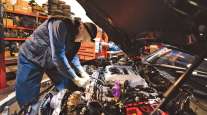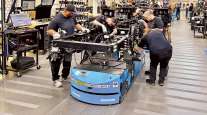Staff Reporter
C.H. Robinson Cuts 650 Jobs Amid Changing Market

[Stay on top of transportation news: Get TTNews in your inbox.]
C.H. Robinson Worldwide Inc. is reducing headcount amid the elimination of 650 positions as part of an effort to align its overall cost structure with market conditions, the company confirmed Nov. 10.
The Eden Prairie, Minn.-based logistics firm is in the process of discussing the matter with impacted employees. The company also is providing transition assistance.
C.H. Robinson executives signaled plans to reduce its workforce when it released it latest financial results.
“As we said last week in our Q3 earnings, changes in market conditions, coupled with many successful endeavors on our digital road map directed at scaling our model to be more efficient, mean we are in a position to reduce our overall cost structure,” Chief Communications Officer Duncan Burns told Transport Topics. “As a result, we’re eliminating some positions at C.H. Robinson.”

Burns
C.H. Robinson said in its Nov. 3 earnings report that quarterly operating expenses had increased 12.4% year-over-year to $599.6 million. The majority of that came from personnel expenses, which increased 9.4% to $437.5 million. The report noted that the increased personnel expenses were primarily due to a 13% average increase in employee headcount.
“These are not easy decisions, because we recognize the significant contribution of the impacted employees,” Burns said. “We have tried to approach this with as much respect and empathy for our former colleagues as possible and are providing transition assistance. We are committed to ensuring that our customers, carriers and partners continue to receive our full focus and that we deliver value to them through this and going forward.”
C.H. Robinson executives noted on the earnings call that scalable digital processes will enable the company to decouple volume and headcount growth while driving increased productivity. The company said it also is focused on opportunities to automate or make self-serve processes, including increasing the digital execution of all touch points in the life cycle of a load.

Chan
“2021 was obviously one of the tightest and most acute freight booms that we’ve seen in a very long time,” Stifel Capital Markets analyst Bruce Chan said. “So having to adjust after a period like that, I think is obviously going to be a little bit more painful directionally than the actual freight volumes that are floating around out there right now would suggest. Second quarter, C.H. Robinson was already talking about an economic slowing, particularly in its freight forwarding division.”
Chan noted that there has been speculation about a potential economic collapse and freight recession. But he doesn’t see the freight environment softening any more than would be expected at the end of a freight cycle. Chan said that what matters most is determining how severe it’s going to be. He has seen people throughout transportation planning for that, especially in the air and ocean freight sectors.

Host Seth Clevenger delves into the TT Top 50 Global Freight Companies list, and how they are preparing for an uncertain future. Tune in above or by going to RoadSigns.ttnews.com.
“I think what surprised us was that they continued to add this head count while out of the other side of their mouth talking about this volume slowing,” Chan said. “I think that was the biggest shock to us. But as of now, I think companies are just positioning themselves for the inevitable end of the cycle. And there’s going to be a freight trough. Again, trying to determine how deep it’s going to be and how long that’s going to last is a different story. So we may see more culling of head counts.”
Chan added that one thing that drove his line of questioning during the investor call was digital freight disruptors have been talking about head count efficiency since 2017; that, in theory, new technologies should make employees more efficient at their jobs. But he noted there hasn’t been clear evidence that these tech investments are helping to drive personnel efficiency, such as the need for adding nonrevenue generating workers for information technology and data science operations.
“In a normal freight cycle, you usually have a little bit more visibility and predictability into how volumes are going to flow and when you need to start ramping up or tamping down on things like hiring,” Chan said. “The pandemic and the post-pandemic 2021 peak were so difficult to forecast and predict, and there were so many complicating factors with all the supply chain disruptions and butterfly effects of things like the port labor situation, periodic lockdowns in China, the Ukraine war, that really causes just a lot of snap volatility and capacity.
“So it is hard to budget and people talk about it a lot on the supply chain side and inventory side, but I think what people have talked about a little bit less is what’s happened on the personnel side.”
C.H. Robinson ranks No. 1 on the Transport Topics Top 100 list of the largest logistics companies in North America.
Want more news? Listen to today's daily briefing below or go here for more info:




